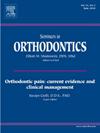A gentle introduction to network meta-analysis for orthodontists
Abstract
Network meta-analysis has been widely used to address the limitations of traditional pairwise meta-analysis. Network meta-analysis incorporates all available evidence into a general statistical framework for comparing multiple treatments. The original Bayesian approach offers a statistical framework to address heterogeneity in the evidence and complexity in the data structure when clinical trials with more than two treatment groups are included. Alternative frequentist approaches have been developed and implemented in commonly used statistical software. The aim of this article is to provide a non-technical introduction to the statistical models and assumptions of network meta-analysis, such as consistency and transitivity, for the orthodontics and dental research community. An example was used to demonstrate how to conduct a network meta-analysis and how to use GRADE and CINeMA tools for placing confidence in the NMA effect estimates in a network meta-analysis. The statistical theory behind network meta-analysis is complex, so we strongly encourage close collaboration between orthodontists and experienced statisticians when planning and conducting a network meta-analysis. Network meta-analysis has been proven to be a very useful tool for evidence synthesis because it improves the efficiency of comparative effectiveness research and the quality of decision-making.

 求助内容:
求助内容: 应助结果提醒方式:
应助结果提醒方式:


